- CITIUS MAG
- Posts
- 2025 USATF Outdoor Championships: Event-By-Event Distance Preview
2025 USATF Outdoor Championships: Event-By-Event Distance Preview
Breaking down the top athletes and matchups to follow across each distance event at the USATF Outdoor Championships.
Presented by Olipop

Flavor-packed, sunshine-ready, and cooler-approved. Grab your beach towel, slather on some SPF, and start sippin’. Get 25% off all your orders at DrinkOlipop.com.
Link here: https://olipop.pxf.io/GmBDD6
Hello again track and field fans! Today we’ll preview all the distance events for this week’s U.S. Championships. As opposed to the Olympic Trials, which stretch out over a week, athletes at USAs are packing their heats, finals, and attempted doubles into just four condensed days of racing. We can expect even more unexpected outcomes in already highly volatile events like the men’s and women’s 800m, but we did our best to make sense of the madness and lay out how to watch each race below.
And if you just can’t get enough track and field coverage, there’s plenty more where that came from:
Each day before the meet begins, tune in to Good Morning Track and Field (presented by Bee Keeper Coffee), where Eric Jenkins and Aisha Praught-Leer give their takes on the action and happenings in Eugene. (Also available on the Off The Rails Podcast feed.)
After each day at the track, tune in for CHAMPS CHATS—Chris Chavez, Eric, Aisha, Anderson Emerole, and Paul Hof-Mahoney will break down all of the results and offer up their analysis from each day’s competition. (Also available on the CITIUS MAG Podcast feed.)
The CITIUS MAG Newsletter will be hitting your inbox daily with a recap of results and a round-up of the best content from the day.
And for those in Eugene, we’ll be hosting two group runs with New Balance, Saturday and Sunday at 8 a.m. PT, meeting in front of Agate Alley on 1461 E. 19th Avenue. There will be coffee, treats, free “I Love Track and Field” t-shirts and the chance to try out the new FuelCell Rebel v5 and FuelCell SuperComp Elite v5. It’s going to be a great time!
Alright—let’s get to it! These are the top storylines and athletes to watch in each distance event at the U.S. Championships.
By Chris Chavez, David Melly, and Paul Snyder
Women’s 800m
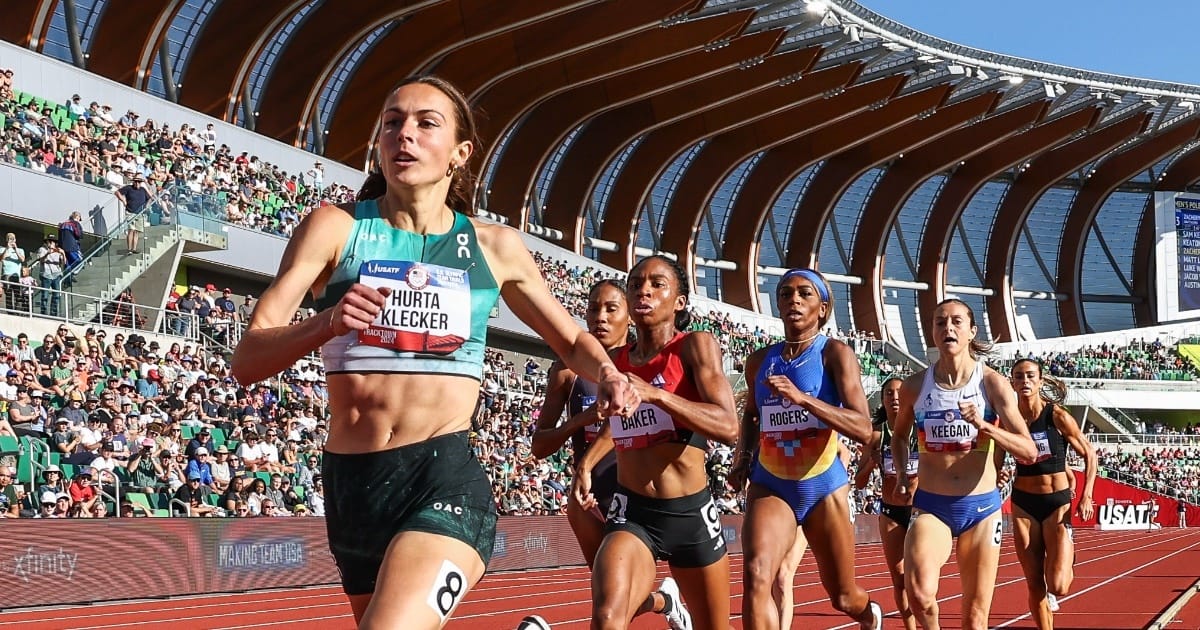
Sage Hurta-Klecker | Photo by Kevin Morris / @kevmofoto
Schedule + How To Watch
Heats: Thursday, July 31st at 3:21 p.m. PT (Watch it on USATF.TV)
Semifinals: Friday, Aug. 1st at 5:04 p.m. PT (Watch it on USATF.TV)
Final: Sunday, Aug. 3rd at 1:18 p.m. PT (Watch it on NBC, Peacock)
Last year's Olympic team: Nia Akins, Allie Wilson, and Juliette Whittaker
Who has the World Championship qualifying standard or is in the World Rankings quota: The U.S. has 13 women who have run under the World Championships standard of 1:59.00 and seven women in the World Rankings quota.
Top Contenders: The women’s 800m at the U.S. Championships is always one of the most dramatic and stunning events. There are early exits in the rounds. Some athletes catch fire throughout the championships and surprise people to make the team. Over four days, your thoughts on who will make the team will change often.
It’s hard not to lead a ‘top contender’ section with the 25-year-old Olympic champion in the group. All eyes will be on Athing Mu-Nikolayev and whether she can round into the form that has made her great in recent years. She does not have the World Championship qualifying standard (2:00.42 SB) but it’s expected that the rounds and final of the championships will require fast enough times for her to check that box eventually. Coach Bobby Kersee has taken a patient approach to easing her back into racing but the results have varied—2:03.44 for last place at the Pre Classic and then 2:00.42 for sixth place at the Ed Murphey Classic in Memphis, where she finished fifth among the Americans. Mu-Nikolayev has the biggest talent and upside of the field and it’s just a question of whether it will show up in time.
Addy Wiley is the fastest American on the year with a 1:57.43 season’s best at the London Diamond League. She has broken 1:59 on four occasions this season. If there’s an athlete you might consider a lock, it’s Wiley—except that she’s 0 for 3 in making the team across the last two championships, doubling 1500m/800m last year but missing the latter final and finishing fifth in the 1500m in 2023.
Sage Hurta-Klecker has the second fastest qualifying time (1:57.53, run last year in Croatia), and has been a mainstay in middle-distance events at US championships over the years, but has never made a global team. If there’s a year she can rewrite that narrative, it might be this one, where things look relatively wide open.
Veteran half-milers Ajeé Wilson and Raevyn Rogers—despite neither breaking two-minutes once in 2024—are both rapidly trending up in 2025, having run in the 1:58 range. Rogers isn’t just the 2020 Olympic bronze medalist in the event, she’s a beloved former Duck who’ll have the Oregon faithful spurring her on, and Wilson is as respected a presence at Hayward as you’ll ever find. Don’t be surprised to see either of them roll back the clock and make another World team.
Then there’s the wave of collegiate talent arriving onto the scene right now: Michaela Rose is always a wildcard with her intense front-running approach, Roisin Willis displayed her tactical savvy en route to an NCAA title this spring, Meghan Hunter and Maggi Cogdon have each shaved off a considerable bit of time from their PRs in recent months, and Makayla Paige tends to run well in championship contexts.
If it feels like we’ve written a ton about athletes who have a good shot to place top three… that’s because there are a ton of athletes who can place top three. This is gonna be a wild ride.
Dark Horses: Interestingly enough, each of last year’s Olympians in this event are probably best classified as dark horses this summer. Nia Akins has struggled with panic attacks this season, Allie Wilson is ramping up off an injury-abbreviated build, and Juliette Whittaker took some time off from competing this spring for mental health reasons. If things fall into place for any of these three, they have just as good a shot as any at qualifying. That said, it feels like a cop-out to call a reigning Olympian a dark horse. So we will go with Valery Tobias, who made the World Indoor team, but has flown largely under the radar since.
One Good Stat: The United States has had at least one woman qualify for every World and Olympic 800m final since 2016—if this is a year for ascendant stars, history suggests they’ll make a splash internationally, too.
Men’s 800m
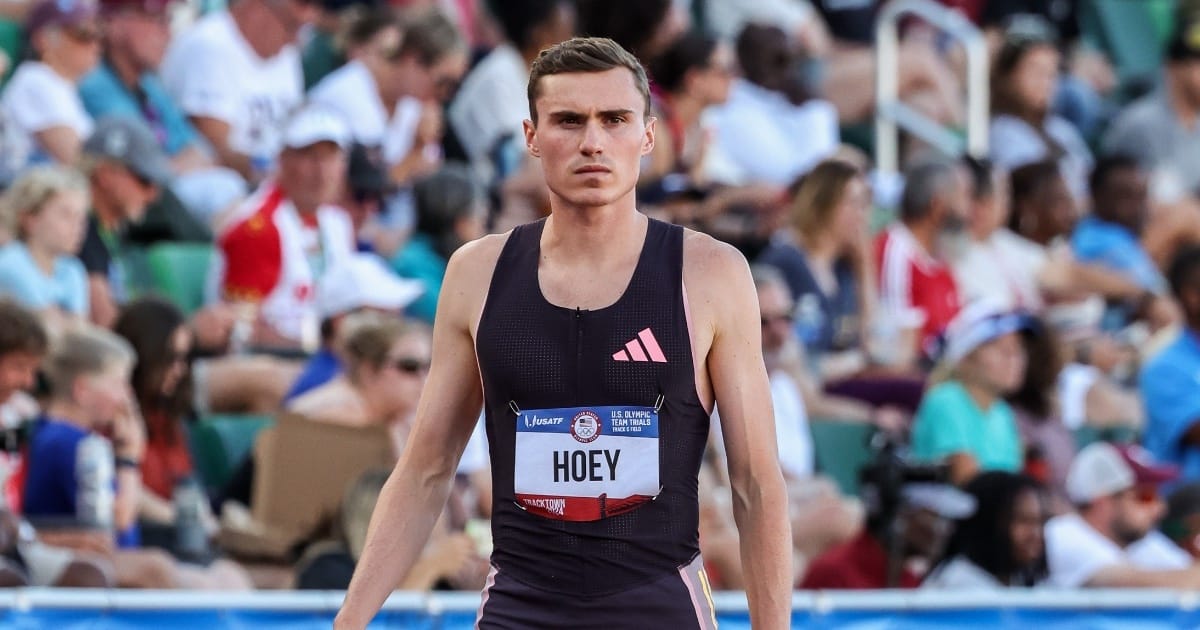
Josh Hoey | Photo by Kevin Morris / @kevmofoto
Schedule + How To Watch
Heats: Thursday, July 31st at 2:55 p.m. ET (Watch it on USATF.TV)
Semifinals: Friday, August 1st at 4:42 p.m. ET (Watch it on USATF.TV)
Final: Sunday, August 3rd at 1:26 p.m. ET (Watch it on NBC, Peacock)
Last year's Olympic team: Bryce Hoppel, Hobbs Kessler, and Brandon Miller
Who has the World Championship qualifying standard or is in the World Rankings quota: Hoppel, Josh Hoey, Donavan Brazier, Jonah Koech, Miller, Kessler, and Abe Alvarado have run under the World Championships standard of 1:44.50; Shane Cohen and Luciano Fiore are in the World Rankings quota.
Top Contenders: It’s not every day the in-his-prime American record holder, fresh off a fourth-place showing at the Olympics, is relegated to presumptive runner-up status. That’s not a knock at Bryce Hoppel. It’s a testament to the historic heater Josh Hoey has been on since placing fourth at last year’s Olympic Trial and just missing the team.
These two feel like safe bets to make the team—or, as safe a bet as any athlete can be in this buzzsaw of an event—but behind them, the picture becomes quite a bit murkier. So much so that we’ll jump over to the dark horse zone right now.
Dark Horses: Donavan Brazier is back, baby. He ran 1:43.08 at the London Diamond League, finishing a ways back from the contenders, but he looked strong in his first taste of international competition. He’s a generational talent and should grow increasingly comfortable racing through the rounds, but he was away from the sport—he last raced regularly in 2022!—for a while, so he’s hardly a known quantity right now.
There’s a reason Brandon Miller keeps making U.S. teams. He is not shy about sticking his nose in races, no matter how hot the pace, and routinely puts himself in position to hold on for second or third at domestic championships.
The Isaiahs—Jewett and Harris—have made teams in the past, but haven’t thus far shown the same form in 2025. They don’t have the standard, but would likely be forced to run under 1:44.50 at some point in the process to make the team.
One Good Stat: The last time Donavan Brazier contested a World Championship—the 2022 edition in Eugene, of all places—he required surgery shortly thereafter and didn’t qualify out of the first round. The winning time that year? 1:43.71, run by Emmanuel Korir, a time that would rank 22nd in the world so far this year.
Women’s 1500m
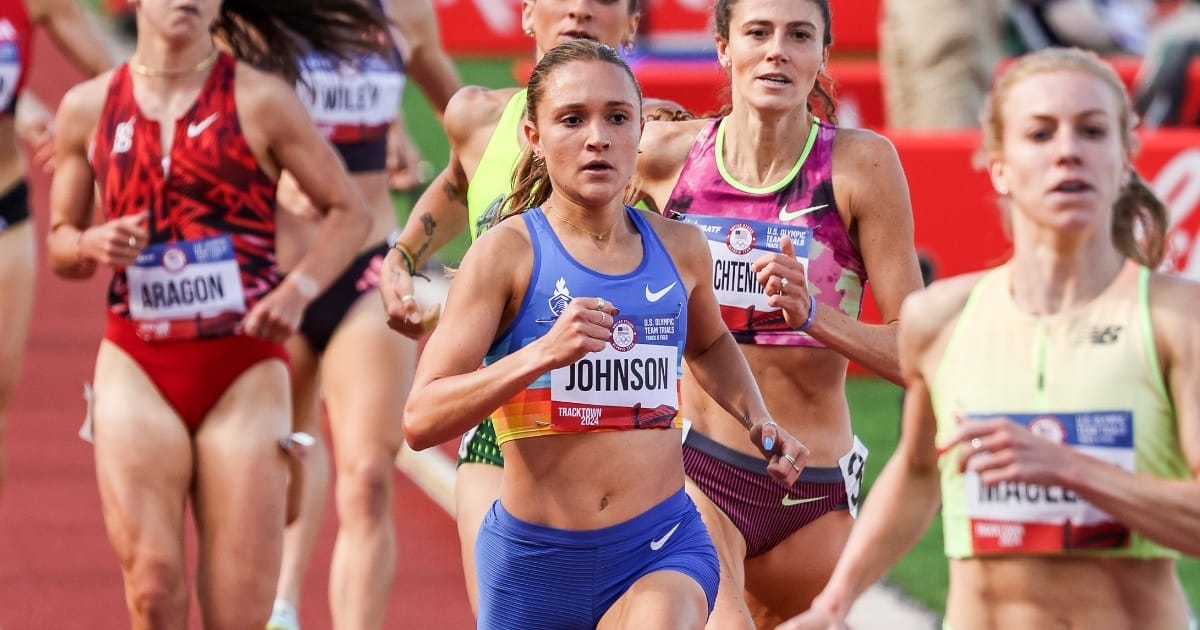
Sinclaire Johnson | Photo by Kevin Morris / @kevmofoto
Schedule + How To Watch
First Round: Thursday, July 31st at 6:54 p.m. ET (Watch it on USATF.TV)
Final: Saturday, August 2nd at 2:03 p.m. ET (Watch it on NBC, Peacock)
Last year's Olympic team: Nikki Hiltz, Emily MacKay, and Elle Purrier St. Pierre
Who has the World Championship qualifying standard or is in the World Rankings quota: The U.S. has eight women who have run under the World Championships standard of 4:01.50 and 12 women in the World Rankings quota.
Top Contenders: We won’t get a replay of last summer’s historically fast Olympic Trials race, spurred on by Elle Purrier St. Pierre’s bold front running. She led the first 1300m of the race and teed up a hard closing Nikki Hiltz to the meet record promised land. Purrier St. Pierre is sitting this one out, having recently given birth to her second child. But in her absence, we’ll get an equally compelling, just as competitive race—just in a different form.
Hiltz hasn’t lost a U.S. 1500m/mile title in their last five attempts, and between that exhibited level of consistency, and a notoriously well-timed closing kick, they come in as the favorite. But they’ll be tested every step of the way by Sinclaire Johnson, who bettered Hiltz’s old American mile record, going 4:16.32 at the London Diamond League meet. Like Hiltz, Johnson can both hang with a quick pace and close maniacally off a slow one. If these two are expected to finish first and second, the battle for the likely third-place-finisher will be much more open-ended.
Emily MacKay, Heather MacLean, and Helen Schlachtenhaufen have all run under 4:00 before, and are experienced championship racers who tend to set themselves up well tactically. MacKay and MacLean have both made U.S. 1500m squads before, but it would be a first for Schlachtenhaufen.
Dark Horses: BYU’s Riley Chamberlain is next fastest by PB (4:02.03), but is textbook dark horse material. She didn’t qualify for the NCAA final in June, but since then has gone on quite the tear—first taking almost five seconds off her 1500m PB in one race, then shaving off nearly two more. She’s anchored BYU’s DMR squads to multiple indoor titles, but has yet to deliver a solo championship performance at that level.
Chamberlain also won the 800m at Stumptown Twilight in 1:59.75, followed closely by Dani Jones in 2:00.19. Jones is another athlete with an outside shot at the team, finishing ninth in last year’s Olympic Trials and running a 4:00.64 PB last summer.
One Good Stat: The explosion of depth and talent in this event cannot be overstated—10 years ago, seven Americans in history had broken four minutes in the women’s 1500m. In the final at least year’s Olympic Trials, eight athletes did it in one race.
Men’s 1500m
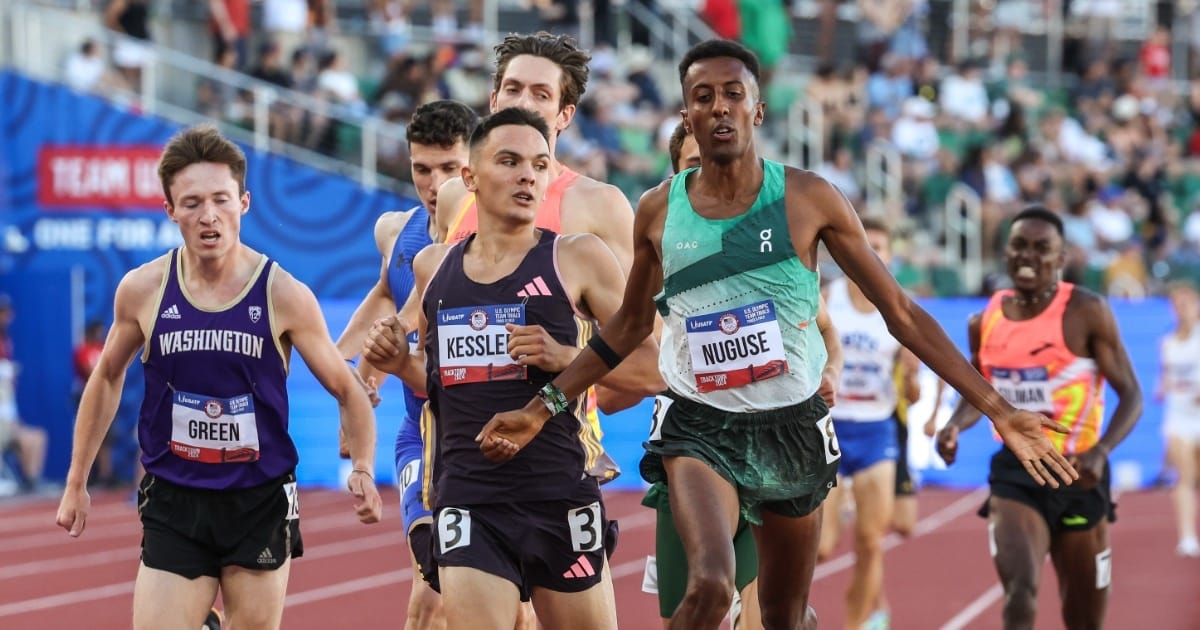
Yared Nuguse | Photo by Kevin Morris / @kevmofoto
Schedule + How To Watch
First Round: Thursday, July 31st at 6:33 p.m. ET (Watch it on USATF.TV)
Final: Saturday, August 2nd at 2:14 p.m. ET (Watch it on NBC, Peacock)
Last year's Olympic team: Cole Hocker, Hobbs Kessler, and Yared Nuguse
Who has the World Championship qualifying standard or is in the World Rankings quota: The U.S. has nine men who have run under the World Championships standard of 3:33.00 and two men in the World Rankings quota.
Top Contenders: Given that the U.S. went first, third, and fifth in this event at last summer’s Olympics, and all three men are back, healthy, and racing reasonably well, it’s not inconceivable the same team will head to Tokyo.
Yared Nuguse has looked the strongest this outdoor season of the bunch, and is coming off a 3:45.95 performance in the Bowerman Mile, losing by a hair at the line. Cole Hocker finished a second and a half back in that race, and holds a lifetime record of 6-11 against Nuguse, but he’s as strong a championship racer as the U.S. has ever seen and has a penchant for peaking at just the right moment. Nuguse will likely assume the lead with 800m to go and start pressing. Hocker will go with him. Either could win—it’d only be a surprise if neither did.
Hobbs Kessler was further back in the pack at Pre, but again… he was fifth place at the Olympics and has raced well enough this year to be given some benefit of the doubt. Plus, he’s not doubling this year after making the Olympic team in the 800m and 1500m last year, so he’ll get to the final fresher, after already exhibiting a workhorse-like ability to navigate round after round.
Dark Horses: The question on everyone’s minds—okay… maybe just American distance running fans’ minds—is “where is Jonah Koech?” Up until late May of this year, Koech was a solid 800m specialist, who repped the U.S. at the 2022 World Championships but failed to make the final. That all changed at the Rabat Diamond League meet, where the 28-year-old won a loaded 1500m in 3:31.43 off a spectacular 53.1 final 400m, to become a globally relevant 1500m runner. The next week, Koech won the 800m at the Kip Keino Classic in 1:43.32, but it’s been crickets ever since. If he’s healthy, he’s a very real threat to make the team—but that appears to be a big if.
Regardless, you’d be wise to keep an eye on two freshly-minted professional milers—Nathan Green and Ethan Strand.
Green hasn’t run the World standard (3:33.00) within the window and isn’t currently in the quota, but given recent American championships, it’s likely he’d achieve both with a top-three finish. He’s unproven in races won in the low 3:30s or faster, but as a two-time NCAA 1500m champ, he’s demonstrated he knows how to run rounds and position himself well in championship races. In a slower race—or if he’s made a leap into 3:30-or-so fitness from his 3:32.20 PB—Green could perhaps give Kessler a scare.
Strand, on the other hand, has run in 3:48 territory twice for the mile, so it’s no secret he can hang onto a hot pace. He’s also shown he can close with the best of them, placing second at this year’s NCAA 1500m final (behind Green) despite having to catch just about the entire field over the last 150m. Strand has what he needs in his toolkit. Does he finally have enough reps under his belt to be where he needs to be coming into the home stretch? If there’s anyone poised to be crowned the Next Big Thing in American Middle-Distance Running, it’s Strand. Could he be ready for the coronation already?
One Good Stat: For some context around just how good this event has gotten in recent years… at last year’s Olympic Trials, Vince Ciattei placed fourth in 3:31.78, which was faster than the old meet record. Hocker won in 3:30.59, and if fourth place this year runs faster than that, expect Chris and Mac Fleet to set a record of their own for “longest, most deranged emergency podcast ever recorded.”
Women’s 3000m Steeplechase
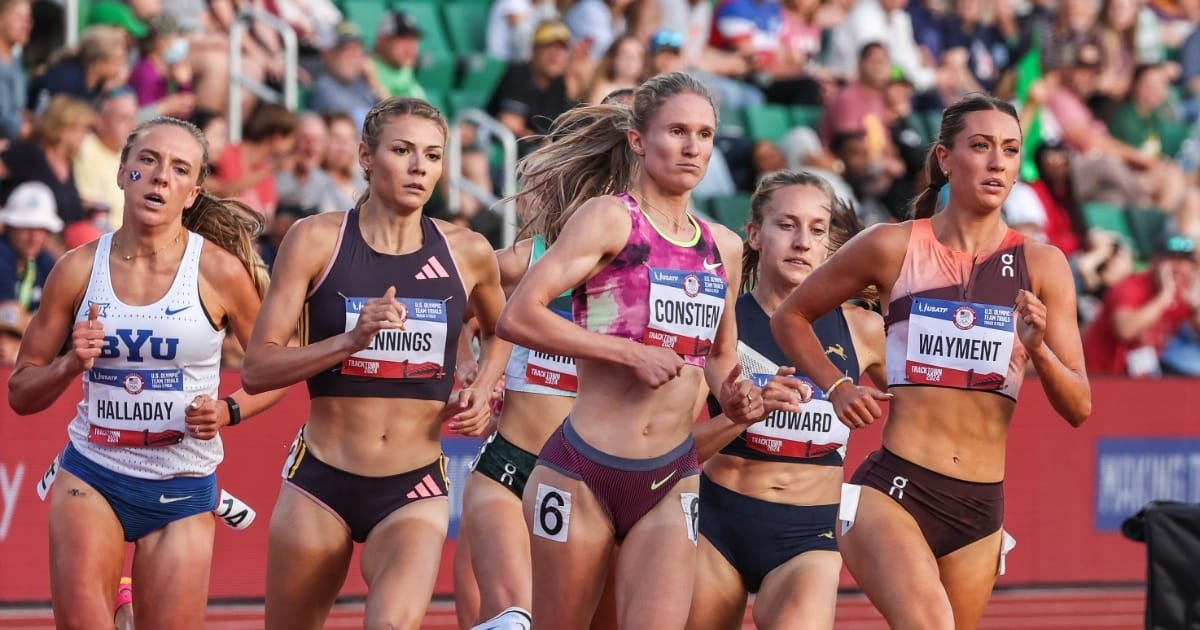
Women’s Steeplechase - 2024 U.S. Olympic Trials | Photo by Kevin Morris / @kevmofoto
Schedule + How To Watch
First Round: Thursday, July 31st at 5:31 p.m. ET (Watch it on USATF.TV)
Final: Saturday, August 2nd at 3:04 p.m. ET (Watch it on Peacock)
Last year's Olympic team: Valerie Constien, Marisa Howard, and Courtney Wayment
Who has the World Championship qualifying standard or is in the World Rankings quota: Constien, Gabi Jennings, Kaylee Mitchell, Lexy Halladay-Lowry, Wayment, Angelina Napoleon, and Olivia Markezich have run under the World Championships standard of 9:18.00; Angelina Ellis and Sophia Novak are in the World Rankings quota.
Top Contenders: The steeple at the Prefontaine Classic provided us with a pretty decent preview of USAs, with many of this week’s contenders lining up against a globally elite field. Gabbi Jennings and Kaylee Mitchell were the top two American finishers, finishing in PBs of 9:06.61 and 9:08.66. Lexy Halladay-Lowry was next up, running just off the 9:08.68 she posted in her second-place NCAA championship performance from June.
The four other Americans in that race didn’t quite have A+ days, but if they do here, they’re just as likely to podium as the trio discussed above. Val Constien is the third fastest American steepler ever, and bounced back from a “meh” race at Pre with a 4:07 1500m PB the next week. Krissy Gear has shown flashes of brilliance at U.S. Championships in the past, particularly when the pace dawdles and it comes down to a kick—as it very well might without the presence of a Winfred Yavi upfront. Olivia Markezich and especially Courtney Wayment are both better than their performances at Pre, and slot into the same tier as the other top contenders on a more typical day.
Dark Horses: Angelina Napoleon’s progression this season—she entered the 2025 campaign having run 9:54.08 and now is seeded at 9:10.72 heading into USAs—is already the stuff of legend. That said, she’s been on a long haul this year. If there’s anything left in the tank and she can chisel a few seconds away for the umpteenth time, she’s got a long shot at top-three.
One Good Stat: Allie Ostrander is the only athlete in the field whose season best was run en route to a win. She has run exactly one steeplechase this year: an entirely solo 9:35.11 in a three-woman field the other weekend in Portland.
Men’s 3000m Steeplechase
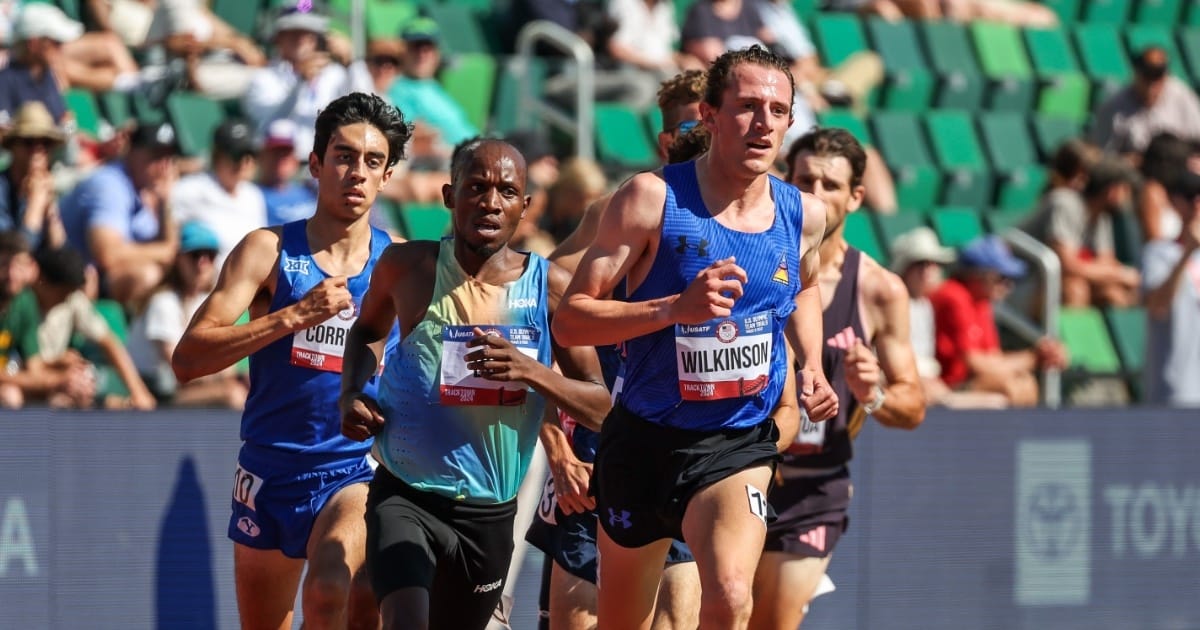
Matt Wilkinson | Photo by Kevin Morris / @kevmofoto
Schedule + How To Watch
First Round: Thursday, July 31st at 6:03 p.m. ET (Watch it on USATF.TV)
Final: Saturday, August 2nd at 2:49 p.m. ET (Watch it on Peacock)
Last year's Olympic team: James Corrigan, Kenneth Rooks, and Matt Wilkinson
Who has the World Championship qualifying standard or is in the World Rankings quota: Rooks, Wilkinson, Isaac Updike, Duncan Hamilton, Nathan Mountain, and Corrigan have run under the World Championships standard of 8:15.00.
Top Contenders: Last year’s three Olympians were all first-timers, and with the possible exception of Rooks, all were surprises to make the squad. That sort of sudden upshift in expectation can present a real challenge. And it’s even tougher to live up to your newly-elevated promise when you pull off the shocker of the steeplechasing century and nab an out-of-left-field silver medal the way Kenneth Rooks did. Rooks has by no means had a bad season. He just hasn’t put up many results to suggest he’s the second best steepler on the planet right now. Still, the reigning Olympic second-placer has to be considered a top contender, and he does come in having run a top-three time by an American this year.
Matt Wilkinson has cemented himself as the closest thing to a favorite we have here. He’s run 8:11.11 and 8:10.23, both in Diamond League settings, and looked very much the part of a global championship finalist. Because of his collegiate racing obligations, James Corrigan’s only international steeple since Paris was the Monaco Diamond League, where he finished three seconds back of Wilkinson. Meanwhile, Isaac Updike, who has been a mainstay on the domestic steeple scene for a decade, has slowly been whittling away at his PB. This year, he got down to 8:13.64, making him the second fastest American in the field in 2025.
Dark Horses: Nathan Mountain has the coolest name in the field, has run 8:14.43, and is wedged between Rooks and Corrigan on the entry list. He’s also notably run a respectable 3:38.94 1500m, winning his section at a low-key meet in Brussels. When the seed times are this close, and only one athlete (Wilkinson) appears to have given himself a half step on the field, that’s the sort of variable you’ve gotta factor in!
One Good Stat: This will be Evan Jager’s 11th U.S. championship. He won every U.S. title in the steeplechase from 2012 to 2018.
Women’s 5000m
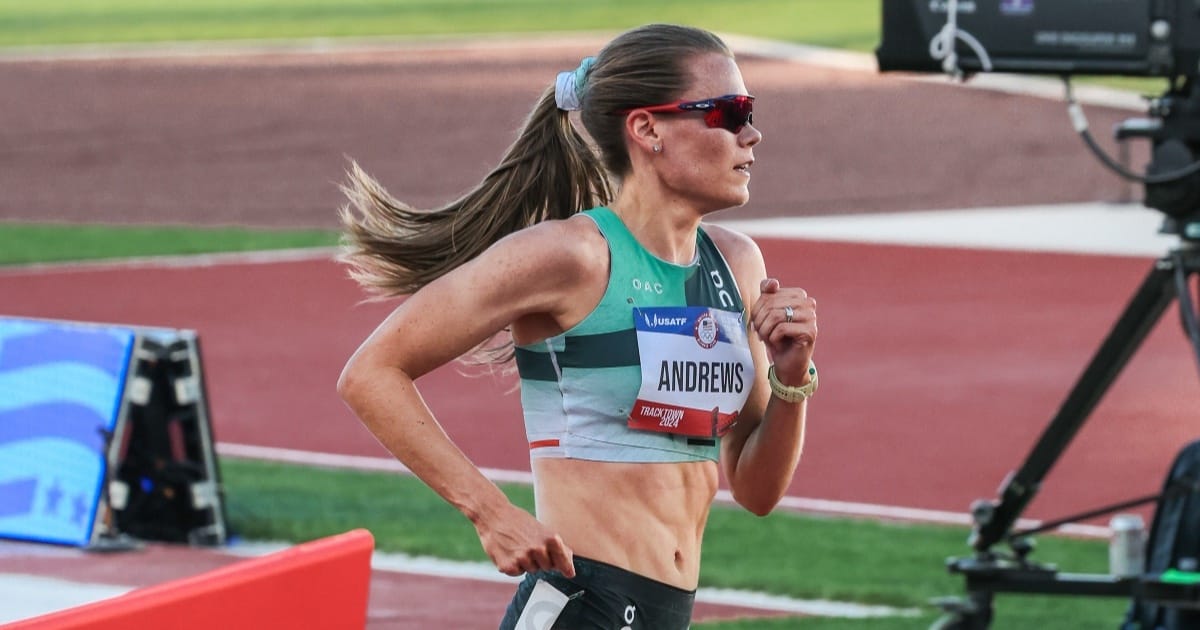
Josette Andrews | Photo by Kevin Morris / @kevmofoto
Schedule + How To Watch
Final: Sunday, August 3rd at 2:31 p.m. ET (Watch it on NBC, Peacock)
Last year's Olympic team: Elise Cranny, Whittni Morgan, and Karissa Schweizer
Who has the World Championship qualifying standard or is in the World Rankings quota: The U.S. has nine women who have run under the World Championships standard of 14:50.00 and six women in the World Rankings quota.
Top Contenders: Of the 2024 Olympic contingent, Whittni Morgan isn’t competing as she’s pregnant with her first child, Elise Cranny is still looking to find her footing after a challenging, racing-intensive spring on the Grand Slam circuit, and Karissa Schweizer is similarly looking for things to click when they matter most. Both will be doubling back from the 10,000m.
It’s unusual for an athlete who has never made a U.S. team before to be considered the prohibitive favorite, but that’s just where Josette Andrews finds herself, thanks to a 14:25.37 breakthrough PB at the Rome Diamond League. No American has run within 14 seconds of that time in 2025—the closest athlete on the list is Weini Kelati, who will be doubling back from the 10,000m.
Behind this group, Shelby Houlihan and Emily MacKay appear to be the next women up, based on recent performances. Houlihan’s indoor season was highlighted by a silver medal in the 3000m at World Indoors, but she hasn’t looked quite as sharp outdoors. MacKay last raced a 5000m in March, and has instead focused on the 800m and 1500m outdoors, and has been a steady performer.
Dark Horses: Again, this feels like a cop-out—after all, she’s the American record holder in the event—but Alicia Monson was out for so long with injury that she doesn’t currently have the 14:50.00 standard, and given she’s only finished one race since February of 2024, she’s not in the quota. She opened up on July 12th with a 15:01.63 showing, after just two months of training. And she’s talented enough that lopping an additional 12 seconds off that time while closing the gap on her peers doesn’t feel like a stretch.
One Good Stat: Either Schweizer or Cranny has made every outdoor U.S. team in the 5000m since 2018.
Men’s 5000m
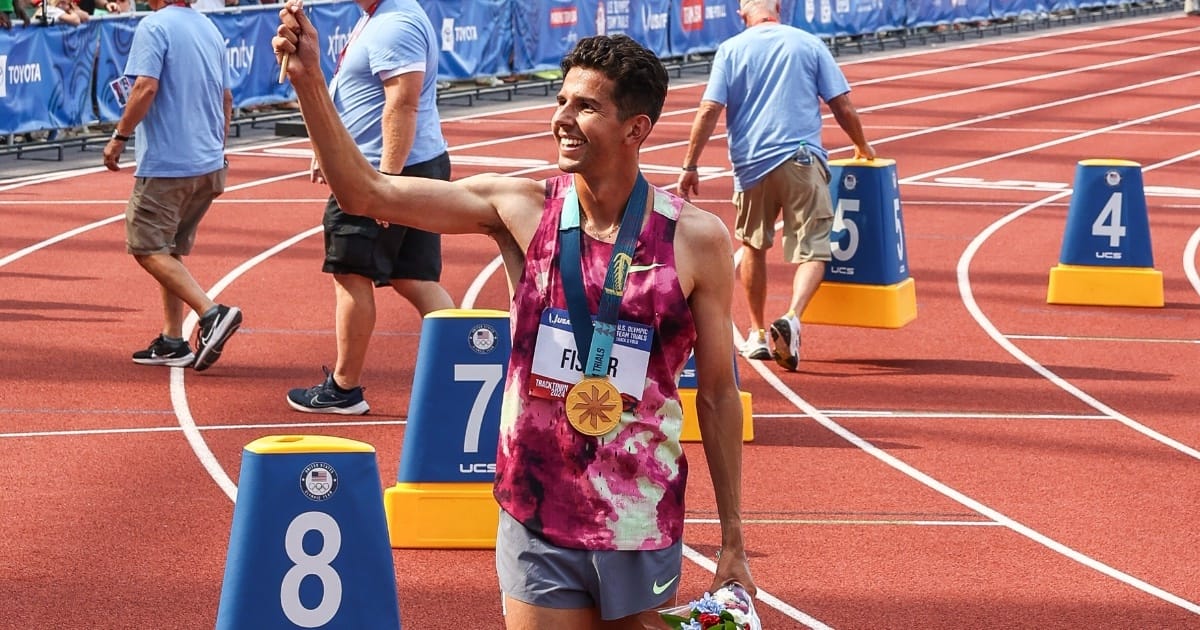
Grant Fisher | Photo by Kevin Morris / @kevmofoto
Schedule + How To Watch
Final: Sunday, August 3rd at 1:52 p.m. ET (Watch it on NBC, Peacock)
Last year's Olympic team: Graham Blanks, Grant Fisher, and Abdi Nur
Who has the World Championship qualifying standard or is in the World Rankings quota: Fisher, Nico Young, Blanks, Cooper Teare, and Cole Hocker have run under the World Championships standard of 13:01.00; Dylan Jacobs and Morgan Beadlescomb are in the World Rankings quota.
Top Contenders: Grant Fisher is the reigning Olympic silver medalist and popped off a 3:48.29 mile at Pre. Barring calamity, he’ll finish top three. Nico Young and Graham Blanks—both of whom had killer races at the Bislett Games, with Young securing his first Diamond League win—make the most sense to round out the top three.
But Cooper Teare will have freshness on his side, as he’s all in on the 5000m. He can close and he’s run under 13 this year—put that all together and he’s best situated to pull an upset out of anyone else.
Dark Horses: That said, Fisher, Young, and Blanks are all doubling, so here’s the standard disclaimer that races aren’t run on paper, and that any of these guys could opt to sit out the 5000m if they didn’t like—or really like—what they saw in their first event.
Hocker is also doubling, but he seems confident in his ability to run a hard 5000m on legs that have withstood multiple 1500m races, or else he wouldn’t have declared. Nobody in the field—and possibly the world—can hang with his kick if he’s firing on all cylinders. Dylan Jacobs and Morgan Beadlescomb would go to Tokyo with a top-three finish. They’re both talented, and reasonably strong closers. It could happen.
Parker Wolfe hasn’t had the smoothest ride to Eugene—he hasn’t strung together more than a couple months of consistent work since his incredible indoor campaign. But after a multi-month racing hiatus starting in April, Wolfe ripped the bandaid off this month with a 3:34.44 1500m at Stumptown Twilight. If the engine is primed, the wheels appear to be willing. Wolfe is a supreme talent, who placed third at the Trials last year but lacked the standard. It’s a long shot, but with a top three finish this time around, the schedule allows for him to chase the time this year.
One Good Stat: Since 2020, Abdi Nur is the only American man without a sub-13 PB to make multiple U.S. teams in the 5000m. Nur is battling back from a torn tendon at last summer’s Olympics and a subsequent surgery—his 13:34.86 season’s best makes him a long, long, long shot, but that race did come in a victory and he does have a track record of exceeding expectations at U.S. championship events.
Women’s 10,000m
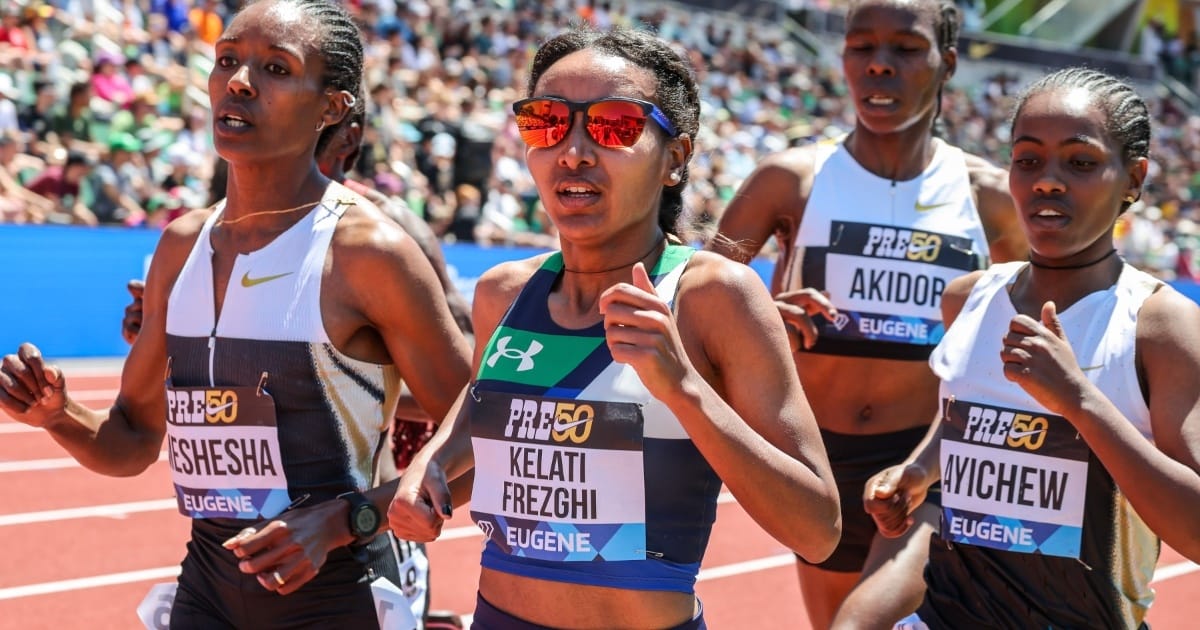
Weini Kelati | Photo by Kevin Morris / @kevmofoto
Schedule + How To Watch
Final: Thursday, July 31st at 7:45 p.m. ET (Watch it on USATF.TV)
Last year's Olympic team: Weini Kelati, Karissa Schweizer, and Parker Valby
Who has the World Championship qualifying standard or is in the World Rankings quota: The U.S. doesn’t have any women who have run under the World Championships standard of 30:20.00. Kelati, Schweizer, and Valby are in the World Rankings quota.
Top Contenders: As per annual custom, Chris Chavez wrote about 2,000 words about the women’s 10,000m at USAs and what needs to play out for the athletes not in the quota to rep Team USA in Tokyo. (You can check out our deep dive into qualification scenarios here.) Parker Valby announced she won’t be competing, due to injury, so Weini Kelati and Karissa Schweizer have the easiest path to qualification, as they are the only women in the field in the quota currently. Every other runner needs to boost their World Ranking points. Elise Cranny is best positioned to be the third qualifier, given that she’s the U.S. leader and a top-three placement, as long as she doesn’t run slower than 32:27.90, ought to get her in.
Dark Horses: Emily Infeld—who won World Championship bronze in this event in 2015—should never be counted out at U.S. championships. In her first season as a Brooks sponsored athlete, she’s been running well while bouncing back and forth between the roads and the track. Amanda Vestri or Taylor Roe could conceivably finish top three as well. NC State’s Grace Hartman is out with an injured plantar.
One Good Stat: If this race were run on the roads as opposed to the track, Taylor Roe likely wouldn’t complain. Her personal best in the 10,000m, 30:58.66 set this year at The Ten, is nearly identical to her fastest time over 10km, 30:58, run a few months later at the New York Mini 10K in Central Park.
Men’s 10,000m
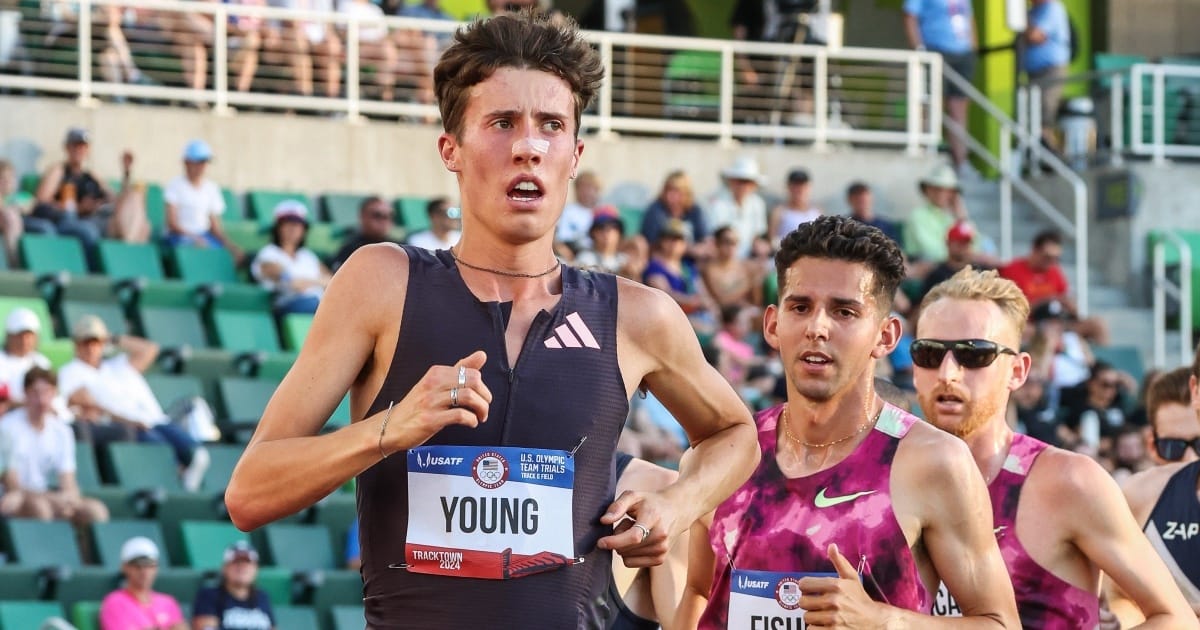
Nico Young | Photo by Kevin Morris / @kevmofoto
Schedule + How To Watch
Final: Thursday, July 31st at 8:30 p.m. ET (Watch it on USATF.TV)
Last year's Olympic team: Grant Fisher, Woody Kincaid, and Nico Young
Who has the World Championship qualifying standard or is in the World Rankings quota: Fisher, Young, Graham Blanks, and Kincaid have run under the World Championships standard of 27:00.00.
Top Contenders: Grant Fisher, Nico Young, and Graham Blanks are the men to beat here. They’re the fastest by PB (26:33.84, 26:52.7, 26:57.30, respectively) and they’ve simply run better across all events than anyone else in the 20-man field over the past year.
Only Woody Kincaid has the standard outside of this trio. He dabbled on the roads this winter and has slowly rounded back into track sharpness—his last race was a 1500m heat two victory at Adrian Martinez in 3:37.47. Wily Woody shouldn’t be counted out, especially if the pace languishes and he’s close enough to the podium to unleash his Hayward-famous kick.
Dark Horses: Nobody else has the standard or is in the quota. The targeted field size for this event at Worlds is 27 and the highest ranked American outside the four men mentioned is Casey Clinger, at 41st. Ahmed Muhumed has run closest to the World standard of 27:00—he went 27:03.19 at The Ten.
With a top-three finish, anybody in the race can technically chase the standard, but this late in the summer, fast 10,000m don’t grow on trees.
One Good Stat: It’s easy to forget that, before last year, Grant Fisher had never won a national title in the 10,000m. Kincaid is the only multiple-time champ in the field, with wins in 2023 and 2021.
Keep up with all things track and field by following us across Instagram, X, Bluesky, Threads, and YouTube. Catch the latest episodes of the CITIUS MAG Podcast on Spotify and Apple Podcasts. For more, subscribe to The Lap Count and CITIUS MAG Newsletter for the top running news delivered straight to your inbox.
